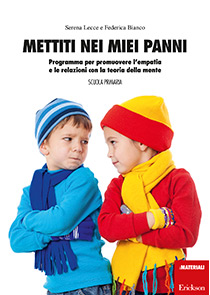 EN
EN
 PT
PT


“Put Yourself in my Shoes” is a program to strengthen the theory of mind abilities in primary school children, created by a group of researchers from the University of Pavia (LASC), and to be used by teachers, educators, and workers in their daily activities with children.
THE ADVANTAGES OF USING THE THEORY OF MIND AT SCHOOL
Frequently, teachers and educators lament about the general difficulty their students have with “seeing things from another point of view,” recognizing others’ needs and being aware of them.
In this context, the theory of mind—that is, the capacity to put yourself in another’s place—represents a resource for the individual’s ability to develop and maintain good relationships with others (both dyadic and in a group) in the home and at school, with teachers and classmates, improving social competence.
In the school context, a connection between theory of mind and academic achievement was noted. In particular, theory of mind seems to influence reading comprehension ability, the area of metacognition, and sensitivity to criticism.
The recognition of the importance of the theory of mind for the development of social, relational and cognitive skills of the child, has led researchers to develop intervention programs to promote this ability.
THE STRUCTURE OF THE BOOK
In detail, “Put Yourself in my Shoes” is made up of 6 work units.
The subject of each unit is a specific manifestation of the theory of mind for the primary school age group
In the workbook section “Put Yourself in my Shoes—Worksheets for the Child”, there are two stories for each of the six categories: an initial story, and one for consolidation. They have been put in order based on a sequence of increasingly complex situations
| SUGGESTED TARGET | CATEGORY OF THE THEORY OF MIND TREATED | STORIES | LEVEL |
| PARTICULARLY AIMED AT YEAR ONE AND TWO OF PRIMARY SCHOOL | 1. Second-order false belief | Cookies | Initial |
| The Sticker Book | Consolidation | ||
| 2. Persuasion | The Test | Initial | |
| Homework and Ice-Cream | Consolidation | ||
| PARTICULARLY AIMED AT YEAR THREE, FOUR AND FIVE OF PRIMARY SCHOOL | 3. Social Gaffes | The Toy Airplane | Initial |
| The Art Show | Consolidation | ||
| 4. Sarcasm | The Book and the Doll | Initial | |
| The Puppy and the Bad Grade | Consolidation | ||
| 5. The Double Bluff | The Snack Trick | Initial | |
| The Hiding Place for Candy | Consolidation | ||
| 6. Misunderstandings | The Ball and the Window | Initial | |
| The Runaway Cat | Consolidation |
Each story is followed by three types of exercises, each one indicated by a specific icon:
To facilitate learning for the child and provide a conscious execution of the program by the teacher, two points of study for each story are also proposed:
In the section “Put Yourself in my Shoes – Indications for the teacher/educator", some schemes of work have been proposed for each activity that present a scheme to set up the discussion following each of the three exercises in order to support the teachers in the application of the program. Example»
These schemes of work are intended to be used as a general point of reference, but can be modified and adapted according to the responses of the children and the level of the class as a whole, provided that the general principle of explaining the mental states underlying the behavior of the characters is maintained.